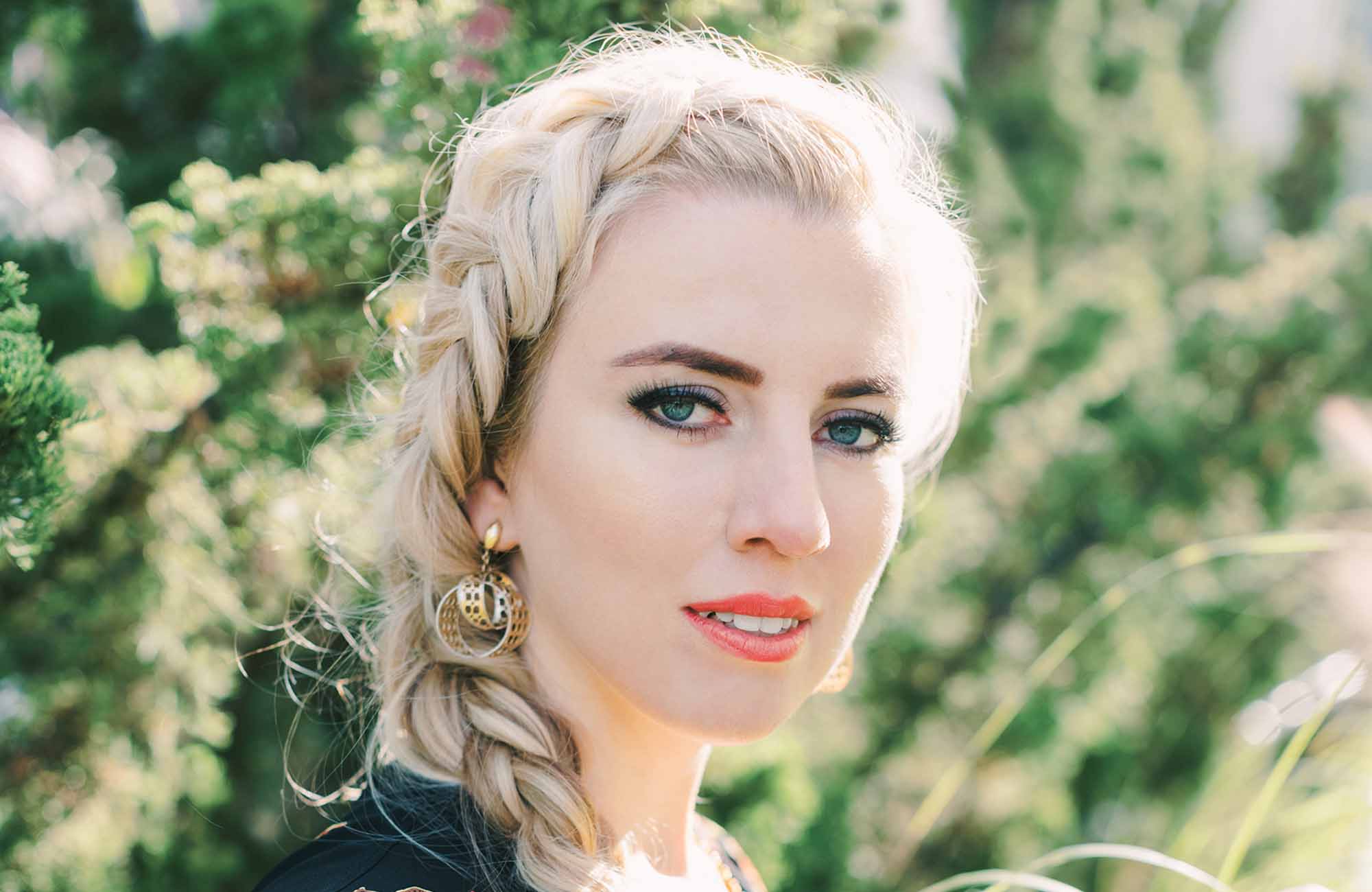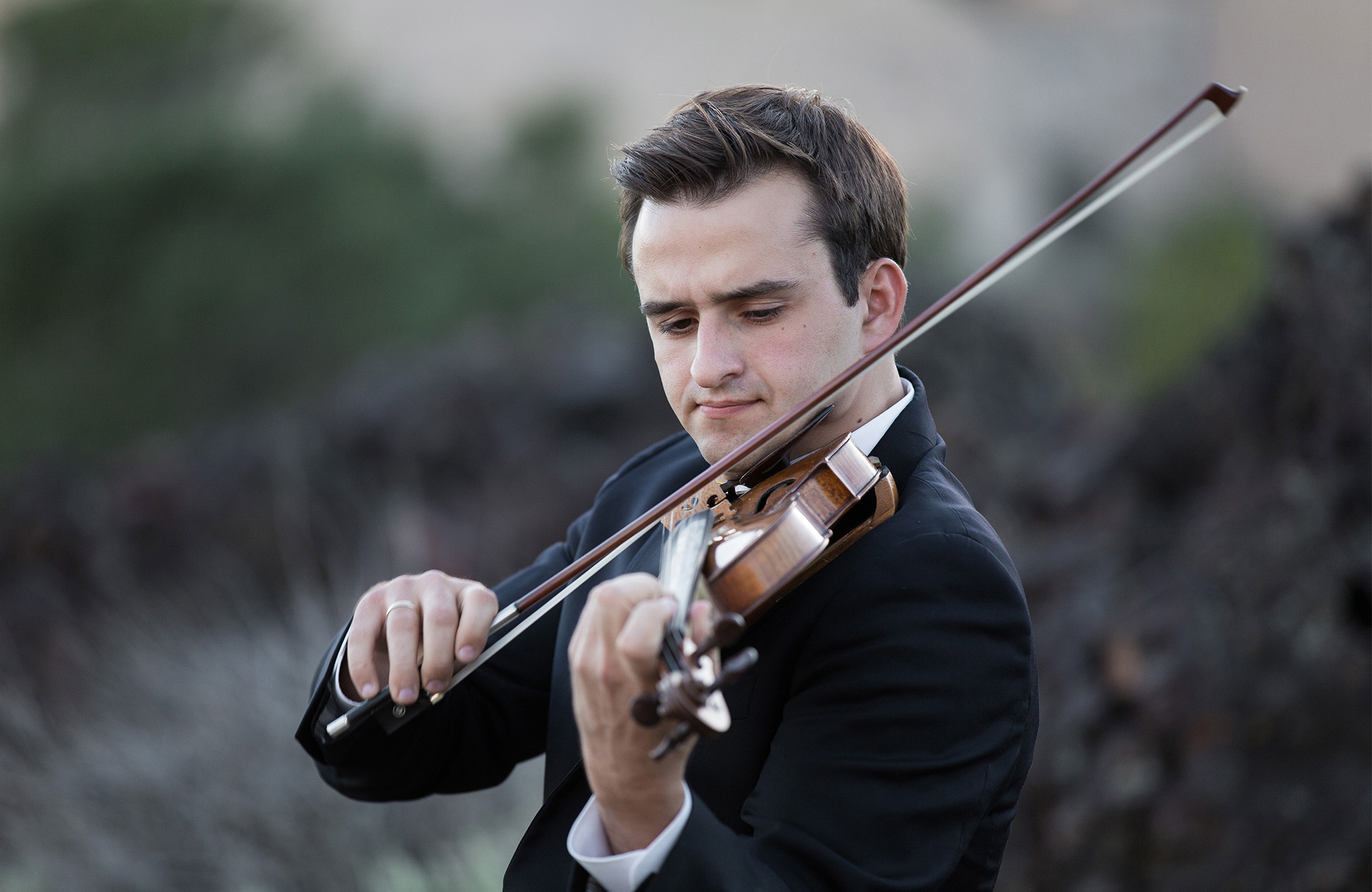Pianist Natasha Paremski returns to perform Rachmaninoff’s Rhapsody on a Theme of Paganini. This is the only Rachmaninoff work for piano which Natasha has yet to perform with The Syracuse Orchestra. The show opens with Berlioz’s Roman Carnival Overture and concludes with Respighi’s famous Pines of Rome.
PRE-PAID PARKING NOTE: The Harrison Street entrance and exit will be closed due to construction outside the building. All vehicles with a maximum clearance of 6’5″ are encouraged to use the upper Montgomery Street entrance. The Madison Street entrance and exit clearance is 6’5″ and should be used to exit the garage.
PROGRAM
BERLIOZ: Roman Carnival Overture ![]()
RACHMANINOFF: Rhapsody on a Theme of Paganini, Op. 43 ![]()
GALBRAITH: Strange Travels ![]()
RESPIGHI: Pines of Rome, P. 141 ![]()
Thanks to our sponsors for this performance!

Susan R. Klenk
Thank you to our media sponsor:
PROGRAM NOTES
Our concert tonight offers four tributes—two to artists, two to places.
We open the celebration with the 1844 Roman Carnival Overture by Hector Berlioz (1803–1869). The music is drawn from his first opera Benvenuto Cellini, based loosely—very loosely—on the life of the Renaissance sculptor, centering on the casting of his famous statue of Perseus holding the head of Medusa. The opera was originally composed in 1838. The premiere was a disaster, and even after significant revisions, it failed to join the repertoire until the twentieth century. In fact, performances are ...
Our concert tonight offers four tributes—two to artists, two to places.
We open the celebration with the 1844 Roman Carnival Overture by Hector Berlioz (1803–1869). The music is drawn from his first opera Benvenuto Cellini, based loosely—very loosely—on the life of the Renaissance sculptor, centering on the casting of his famous statue of Perseus holding the head of Medusa. The opera was originally composed in 1838. The premiere was a disaster, and even after significant revisions, it failed to join the repertoire until the twentieth century. In fact, performances are still rare (it’s only had a single run at the Metropolitan Opera). But Berlioz was not one to waste good musical material, and he managed to draw two successful orchestral works from his score. One was the overture to the opera itself; the other, which we’re hearing tonight, was an independent work based on the love music and the carnival music from the opera’s first act.
The Roman Carnival Overture has turned out to be one of Berlioz’s most popular compositions. In part that’s because of its melodic invention (especially the love theme) and its rhythmic vitality. Even more, though, it has attracted listeners because of its spectacular color. Berlioz was a pioneer in this area, the first canonical composer to treat sound per se as an element equal to melody, harmony, and rhythm. The use of the English horn to announce the love theme, the unexpected appearance of tambourines during the carnival music, his incorporation of the newly developed “cornet à pistons” (a valved instrument that had, among other qualities, more melodic flexibility than the unvalved trumpet of the time), and his promotion of the brass and percussion more generally: all this timbral innovation produced a level of sonic excitement few other composers of the day could match.
The Rhapsody on a Theme of Paganini by Sergei Rachmaninoff (1873–1943) is, like the Berlioz, an homage to a great artist. In this case, the composer, arguably the greatest pianist of the 20th century, offers his respects to the greatest violinist of the 19th, Nicolò Paganini (1782-1840), using Paganini’s familiar 24th Caprice for solo violin as his starting point. (Rachmaninoff’s work can also, less directly, be seen as an homage to the greatest pianist of the 19th century, Franz Liszt, who also recast Paganini’s virtuosic violin music for piano).
Born in Russia, Rachmaninoff emigrated after the Revolution, living briefly in Europe before settling in the United States in 1918. (He did, though, continue to spend many of his summers on Lake Lucerne in Switzerland). He continued his successful career as a pianist, but his output as a composer dropped considerably. Other than a series of brilliant transcriptions and arrangements, he wrote only six works in the last 25 years of his life. It’s hard to be sure what caused the slowdown; it was certainly not any loss of compositional skill, since these works are among his most finely crafted. Even so, most of his late music—falsely derided by critics as “old-fashioned”—was slow to catch on, achieving widespread popularity only after his death. The exception is the Rhapsody, a hit from its first performance in 1934.
On the surface, the Rhapsody seems at first to follow a traditional theme-and-variations format, offering us 24 short and very different “microcosms,” to use a term suggested by tonight’s soloist Natasha Paremski. “Every variation,” she says, “feels different.” But over and above its rapid-fire shifts in tone—including, she believes, several variations influenced by Rachmaninoff’s interactions with American jazz—there are a few formal twists. First, at the very beginning, Rachmaninoff mixes things up. He starts off, conventionally, with an introduction; but then, instead of presenting the theme, he gives us the first variation, only providing the theme itself after that—as if, in his enthusiasm to begin, he’d forgotten about it. Second, as the work continues, we discover that the variations are superimposed over a three-movement structure of the sort you find in traditional concertos, including Rachmaninoff’s: the first ten variations correspond to an up-tempo first movement, the next eight to a traditional slow movement, the last variations to a finale.
Most striking, though, besides the main theme, there is a secondary theme snaking through the Rhapsody: the Dies Irae, the plain-chant setting of the “day of wrath” from the Latin Requiem Mass. It’s an especially appropriate musical allusion, since Paganini’s virtuosity was so great that during his lifetime he was rumored to be in league with the devil. Does this connection suggest a story behind the music? Yes, says Natasha. And indeed, a few years after the work’s composition, Rachmaninoff and choreographer Michael Fokine worked together on a narrative ballet using the Rhapsody. She elaborates: “Towards the beginning of the piece, there’s the appearance of a woman that Paganini falls in love with. The 18th Variation—and even if you think you’ve never heard the Rhapsody, you’ve heard the 18th variation, that’s for sure!—is the culmination of their love. But then he decides, ‘I’m still going to sell my soul to the devil, because I still want to be the most virtuosic violinist that ever lived.’” And how does it end? “It doesn’t end well: you’ve got the Dies Irae, so obviously he goes to hell.” But it happens “in a kind of joking fashion”—since just as we near what sounds like a standard loud ending, there’s an unexpected twist. Rachmaninoff is often considered a humorless composer—in fact, Stravinsky called him a “six-and-a-half-foot scowl.” Not so here.
This scenario may help explain why Rachmaninoff used the Dies Irae theme. But then again, he needed no encouragement. The theme shows up often in the 19th and 20th centuries—in Berlioz’s Symphonie fantastique, in Liszt’s Totentanz, in Mahler’s Second Symphony.… But no composer was as preoccupied with it as Rachmaninoff was, and he turned to it again and again—and again. Here, it first shows up in the piano in the seventh variation, and it nearly takes over the piece as the brass shout it out in the final variation.
What can listeners expect from tonight’s performance? Even if you know the piece well—in fact, even if you’ve heard Natasha play it before (she’s recorded it twice)—you’re apt to hear something new. Although she’s been playing it since she was 11, it’s always changing. True, she says—comparing the work to a building—the “general architecture” remains constant: “You can’t mess around with the beams, unless you tear the whole thing down and start over. But then it’s not the Paganini Rhapsody anymore. It’s a whole different house.” But within the building, you can make changes in the details: “You might do different colors, or a slightly different inflection of the phrasing here, a slightly different voicing over there.” In fact, if the piece is to remain interesting to the audience, you have to do that. “If I’m kept on my toes, you’ll be kept on your toes. But if I’m doing the same thing from night to night, from week to week, nobody’s going to care. Because if I don’t care, why would you care?”
As for people new to the piece: “If you have a chance,” she says, “give it a listen beforehand, so that when you go to the concert, you’ll feel, ‘Yeah, I know this. This piece is my friend. We’ve hung out already.’” The importance of friendship marks not only Natasha’s view of listening, but also her view of performing. “That’s the beauty of playing with The Syracuse Orchestra and Larry Loh. He can read my mind. I can read his mind. I can read the orchestra. Everybody’s reading each other’s mind….” As you know if you’ve attended any of Natasha’s previous appearances in Syracuse, the result is an unusual sense of community.
Strange Travels by Nancy Galbraith (b. 1951) also offers a tribute; but in this case, it’s a tribute not to a person but to two places that she visited on a trip to Thailand: Khao San Road in Bangkok and the ancient ruins at Ayutthaya, a UNESCO World Heritage site that was once a Siamese capital. “The title,” says the composer, “alludes to the sensation of motion imparted by the music, through two aural landscapes of an unfamiliar, almost otherworldly nature.” The “high energy” first movement has a strong minimalist feel, derived from its reliance on the repetition of small gestures, on syncopations, and on metrical shifts, which together create an infectious rhythmic drive that only “dissipates” in the final measures. The second movement has traces of the same elements, but they’re less consistent—and less foregrounded. Rather than energy, the primary quality of this movement, the composer says, is “awe”—specifically, the awe she felt when facing historic ruins that are centuries old. There’s more sustained music here—and even when the music is motoric, it’s often superimposed on majestic brass that gives it a grandeur the first movement didn’t have. Strange Travels was originally composed for chamber orchestra in 2013, but it was revised for full orchestra in 2022. The new version was premiered at Carnegie Mellon University (where Galbraith teaches) by our own Music Director Larry Loh, who of course conducts it tonight as well.
The concert concludes with another tribute to a place: The Pines of Rome, the central panel of the so-called Roman Trilogy by Ottorino Respighi (1879–1936). It’s a programmatic tone-poem in four linked movements, each celebrating a particular spot in Rome, each with a different atmosphere. First, at the “Pines of the Villa Borghese,” we hear the raucous sound of children at play. Even if you don’t already know the song “Madama Dorè,” which is tossed around the orchestra throughout, you’ll recognize it as a children’s song (more specifically, one that accompanies a circle game). The mood changes dramatically for the second movement, “Pines Near a Catacomb”—somber music quoting, as Respighi often did, Gregorian chant. Next, night falls on the “Pines of the Janiculum”—some of the most evocative music the composer ever wrote. Against soft string sounds, we hear a solo piano, followed by a solo clarinet (played “as if in a dream”), joined later on by a flute. From there, the music builds languorously. Eventually—a particularly striking effect—we hear (via a recording) a solo nightingale, and the music descends into silence. Finally, after Respighi at his most sensitive, we have Respighi at his most sensational—the “Pines of the Appian Way,” a vision of ancient warriors, with off-stage brass ringing out in one of the most glorious outpourings of sound in the standard repertoire. A perfect ending to the season.
Peter J. Rabinowitz
Have any comments or questions? Please write to me at prabinowitz@SyracuseOrchestra.org
FEATURED ARTISTS

With her consistently striking and dynamic performances, pianist Natasha Paremski reveals astounding virtuosity and voracious interpretive abilities. She continues to generate excitement from all corners as she wins over audiences with her musical sensibility and powerful, flawless technique.
The 2018-19 season featured recitals in New York and ...
With her consistently striking and dynamic performances, pianist Natasha Paremski reveals astounding virtuosity and voracious interpretive abilities. She continues to generate excitement from all corners as she wins over audiences with her musical sensibility and powerful, flawless technique.
The 2018-19 season featured recitals in New York and Chicago in addition to concerto appearances in North America, Europe and South America. Her recording of Fred Hersch’s Variations on a Theme by Tchaikovsky – commissioned for her by the Gilmore Festival – was released in early 2019 on the Steinway & Sons label alongside Mussorgsky’s Pictures at an Exhibition. In 2019-20 she performs the Rachmaninoff cycle with Symphoria Syracuse, returns to Columbus Symphony, and will perform with the Knoxville, Jacksonville and Charleston Symphonies. She will also give a recital at Herbst Hall in San Francisco.
Natasha is a regular return guest of many major orchestras, including Minnesota Orchestra, San Francisco Symphony, Grant Park Festival, Winnipeg Symphony, Kitchener-Waterloo Symphony, Oregon Symphony, Elgin Symphony, Colorado Symphony, Buffalo Philharmonic, Virginia Symphony, and Royal Philharmonic Orchestra with whom she has performed every year since 2008 in venues such as Royal Albert Hall, Royal Festival Hall, and Cadogan Hall. She has performed with major orchestras in North America including Dallas Symphony Orchestra, Los Angeles Philharmonic Orchestra, San Diego Symphony, Toronto Symphony, Baltimore Symphony, Houston Symphony, NAC Orchestra in Ottawa, Nashville Symphony. She has toured extensively in Europe with such orchestras as Bournemouth Symphony Orchestra, Vienna’s Tonkünstler Orchester, Royal Scottish National Orchestra, Orchestre de Bretagne, the Orchestre de Nancy, Royal Liverpool Philharmonic Orchestra, Tonhalle Orchester in Zurich, Moscow Philharmonic, under the direction of conductors including Thomas Dausgaard, Peter Oundjian, Andres Orozco-Estrada, Jeffrey Kahane, James Gaffigan, JoAnn Falletta, Fabien Gabel, Rossen Milanov and Andrew Litton. In addition, she has toured with Gidon Kremer and the Kremerata Baltica in Latvia, Benelux, the United Kingdom and Austria as well as appearances with National Taiwan Symphony Orchestra in Taipei.
Natasha has given recitals at the Auditorium du Louvre in Paris, Wigmore Hall, Schloss Elmau, Mecklenburg-Vorpommern Festival, Verbier Festival, Seattle’s Meany Hall, Kansas City’s Harriman Jewell Series, Santa Fe’s Lensic Theater, Ludwigshafen BASF Series, Teatro Colon in Buenos Aires, Tokyo’s Musashino Performing Arts Center and on the Rising Stars Series of Gilmore and Ravinia Festivals.
A passionate chamber musician, Natasha is a regular recital partner of Grammy winning cellist Zuill Bailey, with whom she has recorded a number of CDs. Their Britten album on Telarc debuted at No. 1 on the Billboard Classical Chart, remaining there for a number of weeks, in addition to being featured on The New York Times Playlist. She has been a guest of many chamber music festivals such as Jeffrey Kahane’s Green Music Center ChamberFest, the Lockenhaus, Toronto, Sitka Summer Music, and Cape Cod Chamber Music festivals to name a few.
Natasha was awarded several prestigious prizes at a very young age, including the Gilmore Young Artists prize in 2006 at the age of eighteen, the Prix Montblanc in 2007, the Orpheum Stiftung Prize in Switzerland. In September 2010, she was awarded the Classical Recording Foundation’s Young Artist of the Year. Her first recital album was released in 2011 to great acclaim, topping the Billboard Classical Charts, and was re-released on the Steinway & Sons label in September 2016 featuring Islamey, recorded on Steinway’s revolutionary new Spirio technology. In 2012 she recorded Tchaikovsky’s Piano Concerto No. 1 and Rachmaninoff’s Paganini Rhapsody with Royal Philharmonic Orchestra and Fabien Gabel on the orchestra’s label distributed by Naxos.
With a strong focus on new music, Natasha’s growing repertoire reflects an artistic maturity beyond her years. In the 2010-11 season, she played the world premiere of a sonata written for her by Gabriel Kahane, which was also included in her solo album.
Natasha continues to extend her performance activity and range beyond the traditional concert hall. In December 2008, she was the featured pianist in choreographer Benjamin Millepied’s Danses Concertantes at New York’s Joyce Theater. She was featured in a major two-part film for BBC Television on the life and work of Tchaikovsky, shot on location in St. Petersburg, performing excerpts from Tchaikovsky’s First Piano Concerto and other works. In the winter of 2007, Natasha participated along with Simon Keenlyside in the filming of Twin Spirits, a project starring Sting and Trudie Styler that explores the music and writing of Robert and Clara Schumann, which was released on DVD. She has performed in the project live several times with the co-creators in New York and the U.K., directed by John Caird, the original director/adaptor of the musical Les Misérables.
Natasha began her piano studies at the age of four with Nina Malikova at Moscow’s Andreyev School of Music. She then studied at San Francisco Conservatory of Music before moving to New York to study with Pavlina Dokovska at Mannes College of Music, from which she graduated in 2007. Natasha made her professional debut at age nine with El Camino Youth Symphony in California. At the age of fifteen she debuted with Los Angeles Philharmonic and recorded two discs with Moscow Philharmonic Orchestra.
Born in Moscow, Natasha moved to the United States at the age of eight becoming a U.S. citizen shortly thereafter, and is now based in New York.

Described as bringing an “artisan storyteller’s sensitivity… shaping passages with clarity and power via beautifully sculpted dynamics… revealing orchestral character not seen or heard before” (Arts Knoxville) Lawrence Loh enjoys a dynamic career as a conductor of orchestras all over the world.
After an extensive two ...
Described as bringing an “artisan storyteller’s sensitivity… shaping passages with clarity and power via beautifully sculpted dynamics… revealing orchestral character not seen or heard before” (Arts Knoxville) Lawrence Loh enjoys a dynamic career as a conductor of orchestras all over the world.
After an extensive two year search, Lawrence Loh was recently named Music Director of the Waco Symphony Orchestra beginning in the Spring of 2024. Since 2015, he has served as Music Director of The Syracuse Orchestra (formerly called Symphoria), the successor to the Syracuse Symphony Orchestra. “The connection between the organization and its audience is one of the qualities that’s come to define Syracuse’s symphony as it wraps up its 10th season, a milestone that might have seemed impossible at the beginning,” (Syracuse.com) The Syracuse Orchestra and Lawrence Loh show that it is possible to create a “new, more sustainable artistic institution from the ground up.”
Appointed Assistant Conductor of the Pittsburgh Symphony in 2005, Mr Loh was quickly promoted to Associate and Resident Conductor within the first three years of working with the PSO. Always a favorite among Pittsburgh audiences, Loh returns frequently to his adopted city to conduct the PSO in a variety of concerts. Mr. Loh previously served as Music Director of the West Virginia Symphony Orchestra, Music Director of the Northeastern Pennsylvania Philharmonic, Artistic Director and Principal Conductor of the Syracuse Opera, Music Director of the Pittsburgh Youth Symphony Orchestra, Associate Conductor of the Dallas Symphony Orchestra, Associate Conductor of the Colorado Symphony Orchestra and Music Director of the Denver Young Artists Orchestra.
Mr. Loh’s recent guest conducting engagements include the San Francisco Symphony, Dallas Symphony, North Carolina Symphony, Baltimore Symphony, Sarasota Orchestra, Florida Orchestra, Pensacola Symphony, Atlanta Symphony, National Symphony, Detroit Symphony, San Diego Symphony, Seattle Symphony, National Symphony (D.C.), Utah Symphony, Rochester Philharmonic, Indianapolis Symphony, Calgary Philharmonic, Buffalo Philharmonic, Albany Symphony and the Cathedral Choral Society at the Washington National Cathedral. His summer appearances include the festivals of Grant Park, Boston University Tanglewood Institute, Tanglewood with the Boston Pops, Chautauqua, Sun Valley, Shippensburg, Bravo Vail Valley, the Kinhaven Music School and the Performing Arts Institute (PA).
As a self-described “Star Wars geek” and film music enthusiast, Loh has conducted numerous sold-out John Williams and film music tribute concerts. Part of his appeal is his ability to serve as both host and conductor. “It is his enthusiasm for Williams’ music and the films for which it was written that is Loh’s great strength in this program. A fan’s enthusiasm drives his performances in broad strokes and details and fills his speaking to the audience with irresistible appeal. He used no cue cards. One felt he could speak at filibuster length on Williams’ music.” (Pittsburgh Tribune)
Mr Loh has assisted John Williams on multiple occasions and has worked with a wide range of pops artists from Chris Botti and Ann Hampton Callaway to Jason Alexander and Idina Menzel. As one of the most requested conductors for conducting Films in Concert, Loh has led Black Panther, Star Wars (Episodes 4-6), Jaws, Nightmare Before Christmas, Jurassic Park, Casablanca, The Wizard of Oz and Singin’ in the Rain, among other film productions.
Lawrence Loh received his Artist Diploma in Orchestral Conducting from Yale, his Masters in Choral Conducting from Indiana University and his Bachelor of Arts from the University of Rochester. Lawrence Loh was born in southern California of Korean parentage and raised in Carlisle, Pennsylvania. He and his wife Jennifer have a son, Charlie, and a daughter, Hilary. Follow him on instagram @conductorlarryloh or Facebook at @lawrencelohconductor or visit his website, www.lawrenceloh.com






